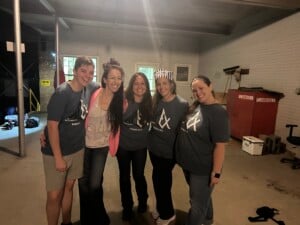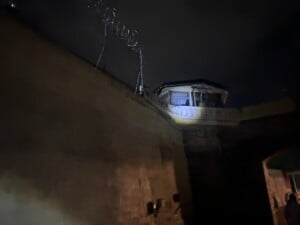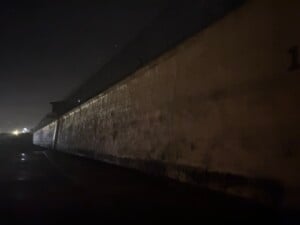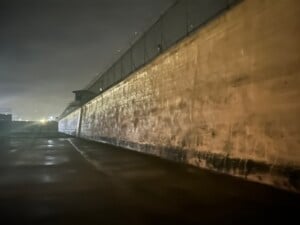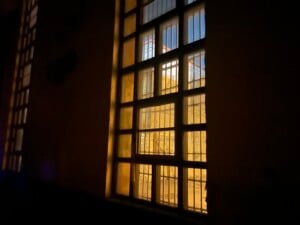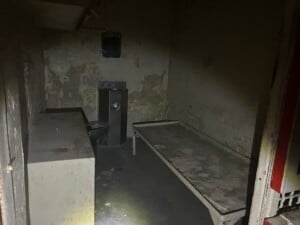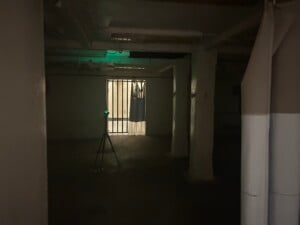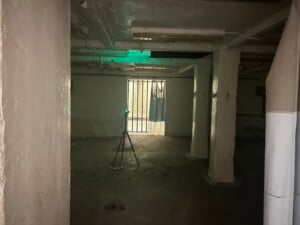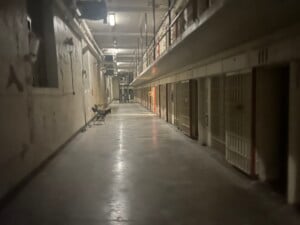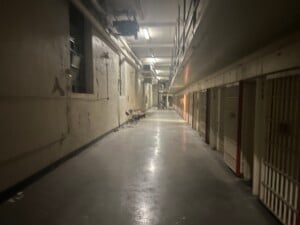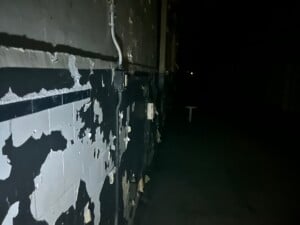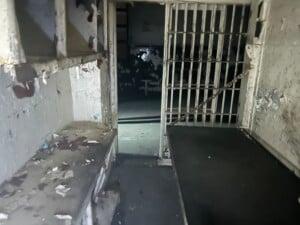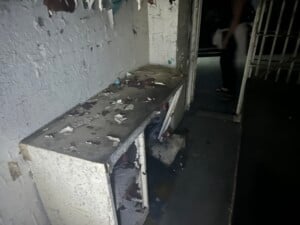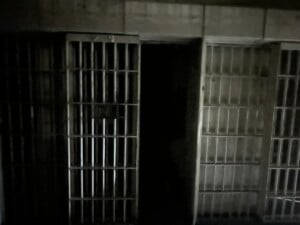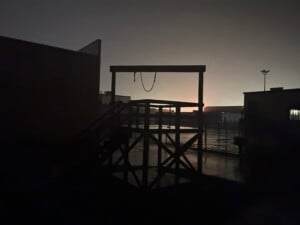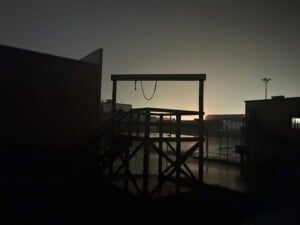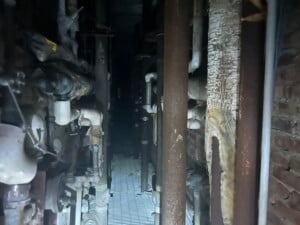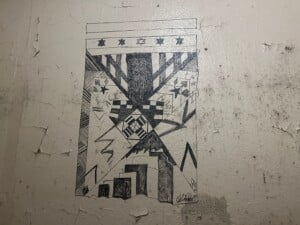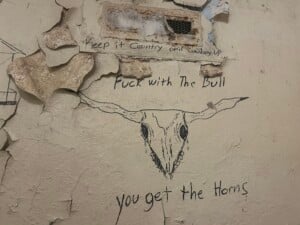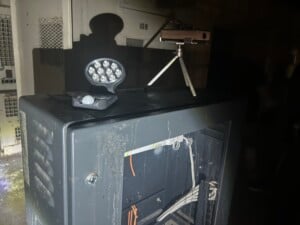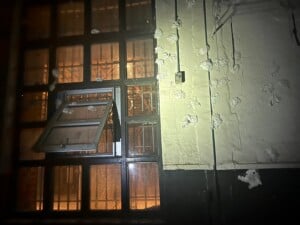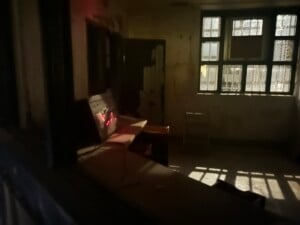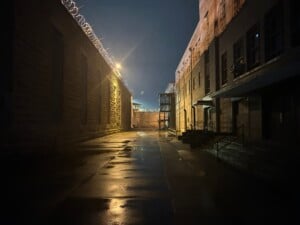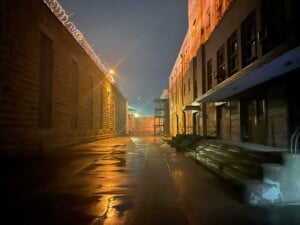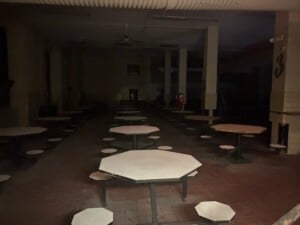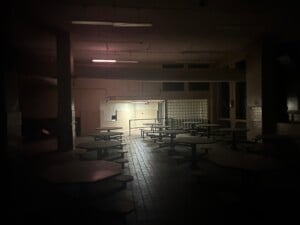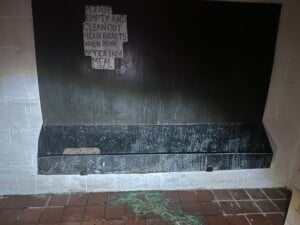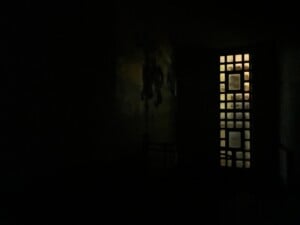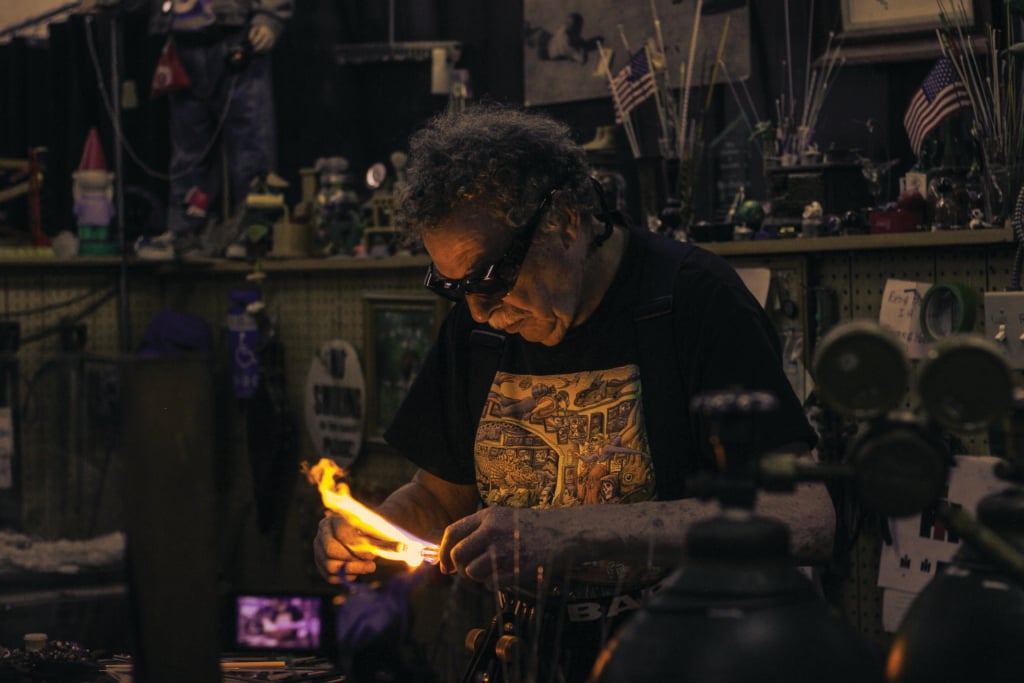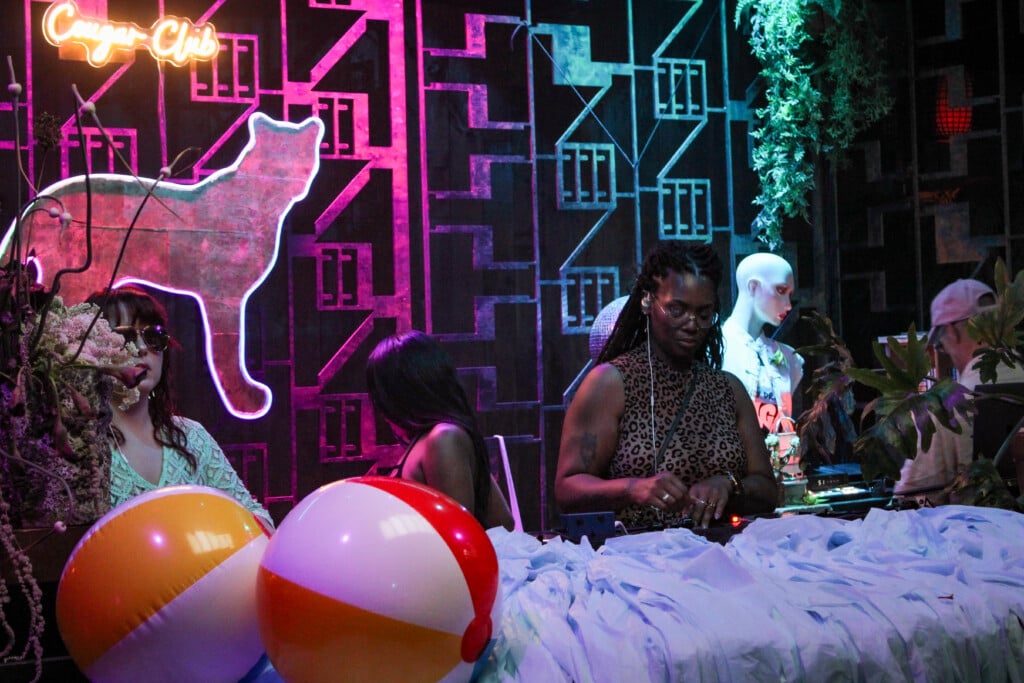A prison ghost hunt, paranormal investigators, and the creeping dread of historic cruelty
I do not believe in ghosts. Or I believe in ghosts. It’s the coward’s choice when it comes to the supernatural.
If I believe in ghosts, they will search me out. I’ve seen Sixth Sense, and I want no part of that. If I don’t believe in ghosts, then I’m the sucker in the horror movie that dies first.
This is the approach I took as I went on a ghost hunt at the Kansas State Penitentiary Museum with Apex Paranormal, one of the premier supernatural investigators of Kansas City.
The museum is actually the original prison. The Lansing Correctional Facility is on the same compound and is still in operation.
The Kansas State Penitentiary was built in 1859. It was in continuous use until 2020, when an uprising about the unsafe conditions during COVID facilitated a move to the newer prison. The limestone used in its construction was quarried by the very inmates that would be held behind those large, impossible stones.
Some of the more notorious inmates that have been housed there were James Lammers, a man who killed his wife and children. Also, there was Lowell Lee Andrews, a true sociopath who shot his mother, father, and sister late one night. He didn’t even know why he did it, and explained to the police that he felt nothing. He was once described as the “nicest boy in Wolcott.”
Then there were Richard Eugene Hickock and Perry Edward Smith, the killers made famous in Truman Compote’s book In Cold Blood. These two men were responsible for killing four members of the Clutter family in 1959. The case grabbed national headlines as the chase for the murderers went all the way from Overland Park and Olathe, Mexico, and finally to Las Vegas, where they were apprehended. They were both hanged on April 14th, 1965.
All of these men ended up at the Kansas State Penitentiary and climbed the famous thirteen stairs to the hangman’s rope. From the gallows, their life was ended, and their afterlife began.
I arrived on a dark and stormy night, and yes, this marks the only time that I will ever write that sentence. This one time, that awful cliché fits. It wasn’t even supposed to rain that night. The prison was imposing when a friend and I arrived for the 8 p.m. tour. Twenty-foot-tall chain link fences crowned with razor wire surrounded the exercise yard, which looked no bigger than an elementary playground. Behind the yard, the building itself stood watch.
It’s a castle on the plains, tall enough to touch the rain clouds. Thick and hopeless walls that make you understand that Andy Dufresne would never be able to dig his way through in twenty years. On the top floor, there is a single lit window. I was told that is where the lethal injection equipment and chemicals are kept, and must always have a light on, even though it’s in the abandoned part of the prison.
There were about sixty people here for the ghost hunt. Our guides divided us up into groups so that we would get a more intimate experience with those behind the veil.
Investigator Morgan Cartwright led our group. There were eight people in our group, and that number stuck in my mind. I was determined to do a head count every time we left a room. I’ve seen the movies. I know how these things work.
The tour began with a walk through an alleyway that reminded me of Jack the Ripper. Morgan asked us to keep our eyes open, as she had seen figures walking back and forth at the end of the alley.
Our first stop was the auditorium, and on stage, there was a man. No, not a man, but the image of one. Johnny Cash stood with his guitar ready to entertain the confined. It was a life-sized cut-out of the man that represented his famous prison concert tour, which had a stop right here in Kansas.
The auditorium reminded me of a high school gym, which should say something about the psychological impact of our education system. This was a flashlight tour, and without those dollar torches, the room was pitch black. On the wings of the stage were two movie screen-sized murals depicting farmers’ daughters dancing. In the darkness, they give the same vibe as seeing a Victorian doll smile.
On stage was the Flux, a pyramid electronic device that you could fit in your hand. The Flux measured environmental changes such as motion and temperature. On top of the pyramid, there are three lights: red, blue, and green. The machine allows ghosts to “talk” to you by changing the color of the lights. It sat next to Johnny Cash as Morgan told his story. When her back was turned, the light flashed green. I was looking right at it.
“Um, that thing just flashed,” I said.
“Oh good, they are coming out. We had some activity here at the 6 o’clock tour. Good to see it’s picking up. The 8 o’clock tour is usually the best for making contact.”
She said it so nonchalantly, as if it was just another Saturday. In my head, I found reasons to explain away what I had seen. It was a trick or dying batteries. I have a brain tumor.
From the auditorium, we moved outside back into Ripper’s Alleyway. The rain picked up as if a director had received his cue and told the crew to make things creepier. Our next stop was the cafeteria.
When the prison was abandoned in 2020, it sat vacant for a number of years, and the weather took it’s toll. Paint was coming off the walls in sheets and revealed generations of history underneath. It hung from the wall and ceilings like bats waiting for sunset. Once again, this place reminded me of my kid’s high school cafeteria, right down to the same type of tables. Round with attached seats spaced evenly apart.
“The guards walked around the perimeter in here. To walk between the tables was dangerous. Sometimes, the spirits will hurl trays that we’ve left out.” So yeah, basically high school.
Attached to the cafeteria was the chapel. It was small, and in no way could it hold the 2,500 prisoners that were at one time incarcerated here. It looked to me like the old, small Gothic churches you find in Southern small towns. This was where cults began.
On the pews are spirit balls, and they were not what I thought they were going to be, as my own high school self laughed at the term. They are cat balls with lights inside of them, spirit toys should they want to play. As my group of eight (yes, I counted), spread out I heared a tapping sound coming from the corner. I walked over because apparently I am the first one to go in a horror movie.
It came from the ceiling, and it was rhythmic. I convinced myself that it was nothing more than water dripping, and when I had that thought, it changed its tempo. The pace picked up. Maybe it was a rat, and he was hosting a rave, and I just heard the drop. I let it go. I do not believe. I do believe. I am neutral.
Outside we went again, and I intentionally erased the drums from my head. More rain, and thunderless lightning flashed across the sky. We passed by the isolation exercise yards, those tiny places for those in solitary confinement and on death row. No bigger than a driveway; a human cage that was once used by the nicest boy in Wolcott.
We arrived in the segregation unit, and I was immediately hit with the smell. It’s not strong or offensive, but undeniably human. Mildew and sweat, urine and feces. These are the cells for the worst of the worst.
The cells themselves were six by eight, just enough for a sleeping bench made out of concrete that is smaller than a twin bed. Those with shelving cut the space down even more so that you had to turn your shoulders to enter. The cells are double-doored, meaning there is the typical prison door with bars, and another door that goes on top of that, so that almost all sunlight is cut away like a tumor. In this place, death is a mercy.
Across from the cells, giant spit wads pepper the wall. Big as a softball, they were the leftover remains of moving day or the riot. What is clear is that people were moved fast enough that cleanup wasn’t a priority. I knew then where the urine smell came from.
We moved through the cell block and Morgan told the story of people seeing hands sticking out of the cells, or the sound of someone throwing pebbles. Little tinks and chips that are distinctive. Everyone grows graveyard quiet and listened, but we heard nothing.
And then we step outside and Morgan points out the gallows. According to Capote, the building where the gallows were kept was known as the coffin. Here, it is explained to us that the museum had recreated the gallows based on the blueprints to be accurate. It occurs to me that they didn’t recreate anything; they just built a new hanging platform, complete with a rope at the top. I’m sure there is a trap door on that thing that works.
As mentioned before, the gallows had thirteen stairs. It’s a legend that this is supposed to represent twelve jurors and one judge. However, in hindsight, it seems like on more psychological dig at the evil that must walk up them. It seems petty, and I don’t think I care. I should, but I don’t.
We arrived at Cell Block D, and here, black paint peels off white tile. I wonder why they painted white tile black. It doesn’t make sense; you generally don’t paint tile. When I looked closer, the tile was perfectly fine underneath the paint. Then I remembered the thirteen steps on the gallows and I let it go.
Cell Block D was built before indoor plumbing and air conditioning. There is a picture that shows what it was like back then. Ten feet across from the cells are bed pans. To imagine that smell, man stink and sewer, stewing in the Kansas heat makes my stomach churn.
There is a shower here, and I stood outside to take pictures. I thought back to the stories of dropping soap in prison. In the middle of the showers is an EMF detector on a tripod. It almost looks like an old digital camera. These measure electromagnetic changes that signal a spirit in the area. I take a picture and turn back. When I do, the EMF beeps loudly. I’m not ashamed to say that I jumped.
“Did you go in there?” Morgan asked.
“Absolutely not,” I said, the idea of dropped soap preventing me.
“Good. We’ve been getting a lot activity in this area tonight. It might be my ghost boyfriend.”
I’m not sure I heard her right, but I had. Apparently, certain spirits have taken a liking to several of the investigators, male and female.
Cell number 124 is apparently the most haunted cell. I took pictures, but I didn’t go in. I approached cell 123 instead, and the shower beeped again. I slid the cell door shut just to feel the weight. The movement was smooth as if it had been greased last week. It felt as heavy as the walls with finger-thick bars with wire mesh in between. I went to open the door but it wouldn’t move. I pulled hard. I used two hands. I called Mike over and he gave it a pull. It didn’t move for him either.
The cells are not supposed to lock on the tour. They should be disabled so that people don’t get stuck inside.
“Hey, aren’t these cells supposed to be unlocked?” I asked Morgan.
“Oh, they are.”
“This one isn’t,” I said, and then pulled on the cell door with just two fingers, barely any pressure at all. The cell door glided open, easier than when it had shut.
“Shit,” I said, and now I actually took several steps back. I begin to rationalize everything in my head. It must have been stuck. Gummed up in the works. Did I actually pull on it or not? I gaslight myself to keep from freaking out.
At the end of the cell block was darkness except for a large unescapable window and a series of ten lights in a straight line on the floor. These are called a Trip Wire, and they use electromagnetic fields to determine if a spirit is nearby. Spirits can communicate by setting off one or all of these lights. It was at this point, after the cell and the beeps, that Morgan decided it was time to take things up a notch.
“Are you shy? Why aren’t you talking to us?” Her tone of voice surprised me. It was condescending and mocking. “I’ve got Raman.”
“Is she shit-talking the ghost?” I asked Mike. “She’s shit-talking the ghost!”
At this point, Morgan had had enough and stomped down the pitch-black hallway to the tripwire. The rest of us, still eight, didn’t move. At all. Not a single solitary movement. Morgan, however, looked like she was a mom about to scold a toddler. And she did.
“Are you here?” she said, and two lights on the tripwire blinked green. “Are you hungry?” The lights blinked again, right in the middle of the line. The other lights stayed steady. “Are you angry?” The lights flashed.
“You guys can go ahead and head back if you want,” she said. “I think this one is Jeremy, the boyfriend.”
Yeah, that’s a hard no from me. This place was a maze, and that’s definitely how the horror movie monster eats your face off. So all of them stayed silent in the darkness, in the smell of mildew and age, and watched Morgan have an argument with her ghost boyfriend.
Eventually, the lights stopped flashing, and the situation seemed to settle. She came back and led us out of Cell Block D and C, past the gallows, back to the alleyway of death, and to the front.
“Did you just shit-talk a ghost?” I asked as we walked.
“He was being rude.”
Manners maketh the spirit.
Back at the beginning, the rain had let up but the prison walls still looked imposing. Mike and I bought t-shirts, said our goodbyes, and headed home.
“That was great,” I said. “That cell door freaked me out.”
“Same. And I heard pebbles being thrown. Like, it started to bother me,” he said.
“Oh, like the story she told?”
“What story?” Mike said.
I think one visit to the Kansas State Penitentiary is enough for me.
